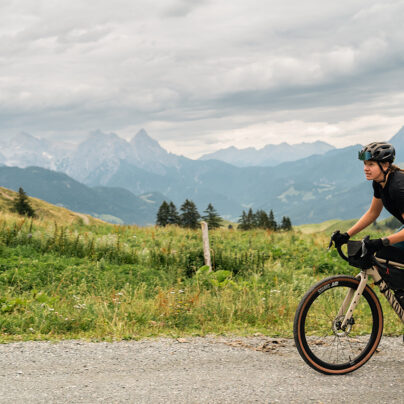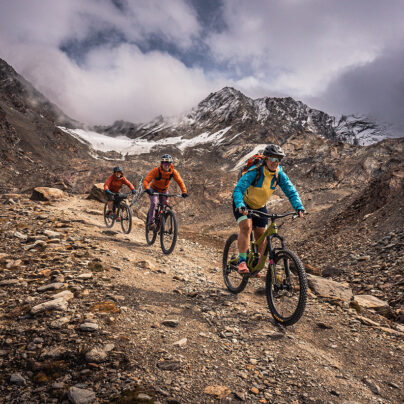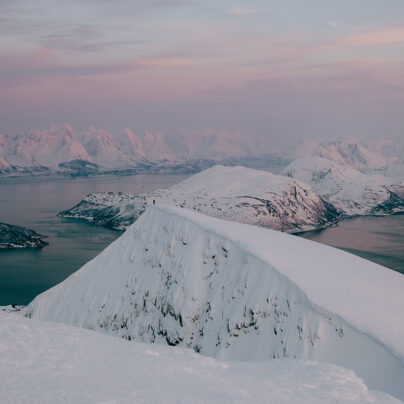Stronger With Time
Fatbiking Across Iceland in Winter
Story & Photography by Joffrey Maluski // Written by Alex Roddie
‘Emotions try to roil within me, catastrophic imminent scenarios, but I ground myself by listing all of the things that I can control.’
In the summer of 2021, I bikepacked across Iceland with two friends: Leo-Paul and Katia. We visited the famous places on Route 1, the Westfjords, and crossed the country from north to south and east to west via the Highlands. I fell in love with this incredible land. And, ever since that trip, I have dreamt of returning in winter. To experience Iceland in its wildest and most elemental form. To challenge myself in the deep cold, and to take my first step from bikepacking to fatbiking. But this time I will not have the solace of companions to lift my spirits on a hard day. This time I will be alone. Just me, a 78kg bike, and 1,000km through the long white darkness.
The Reward
It’s March 1st, 2023, and somehow the months of planning and preparation are already behind me. Somehow I have made it to Egilsstaðir with my bike. Not to mention all my gear and 23kg of food and gas. I’ve spent the last few months refining my kit list, equipping myself with the best gear from the best brands – gear designed for snowstorms and heavy winds.
My itinerary is detailed: a route from Seyðisfjörður in the Eastfjords to Bjargtangar in the Westfjords, crossing north of Vatnajökull, Hofsjökull, and Langjökull. These three huge glaciers will serve as punctuation marks in a journey of almost a month. I have accounted for every detail: river crossings, bridges, huts, every possible Plan B. Unlike our summer bikepacking journey of 2021, which wandered to and fro and was more about exploration than destination, this time I will head purposefully west. With so many unknowns there is little margin for sightseeing.
From Egilsstaðir the first step is to cycle to Seyðisfjörður, as I want to start my traverse by the ocean. It’s only 13km – but there is a 620m pass to climb. My first pedal strokes. It’s happening!
Before this trip a friend had helped me work on important strategies for serious solo journeys such as this. Mental tricks to stay positive, the importance of routine and efficiency, conserving resources… Although this is far from my first big solo expedition, things do feel different this time – or at least I can feel the uncertainty of the weeks ahead pulling me inescapably onwards, like the gravitational field of a black hole. Here and now things do not feel so serious. Remembering the importance of conserving power for my electronics in the cold, I resist the urge to plug headphones in and listen to a podcast. I’m going to have to entertain myself in my own head for some time.



The heavy bike is slow going. But, three hours later, I find myself at the trip’s true starting point: the sea in front of me, shimmering blue-grey against the streaked white slopes of the mountains behind. Now all I have to do is cycle west.
I begin by climbing back up the pass that I have just descended, feeling far more tired, and even slower than only an hour or two before. But I reach the top for my first sunset of the trip. Alpenglow washes over the snow-blanketed mountains, turning all a rose-tinted gold that makes me forget the day-one fatigue. Then I start rolling down the other side of the pass by night, back to Egilsstaðir with the Northern Lights dancing in the sky. It feels like a gift – or, because I have now truly committed, a reward.
Questions
Day five. It’s already late, the snow is getting soft, and I still have 13km to go. The wind’s blowing harder and harder, slamming against me and the bulky outline of my bike. It catches every gust. Those handlebar and fork bags act like sails. Back on the second day in winds like this, I’d deployed my pulka: a lightweight sled that I pull behind my bike, carrying the bulk of my stuff. This helps to reduce wind resistance but comes with a host of other challenges. It’s an unpredictable pendulum weight out there at the rear, sometimes acting like an anchor, sometimes swaying side to side with a will of its own. I have to maintain a steady pace when cycling with the pulka.
Can I actually make it tonight? I think back to the strategies my friend and I discussed before the trip. Just keep going. Don’t think about how big it is. Take it a step at a time. 6km, 4km, 2km. It’s almost night but at last I can see the huts and the snow is better. I pitch my tent in the wind shadow behind a hut, glad to have made 34km in such trying conditions.
Next step: Kistufell hut, 48km across a desert of snow following the north part of the Vatnajökull Glacier. For the first 5km things seem to be going well, with icy conditions allowing a good turn of speed – at least 8 or 9kph. But things get soft. I have to get off and push the bike more and more, and 28km in nine hours feels like a Herculean achievement.
The next day I wake up in my tent (my watch says it’s –13°C), eat a dried meal for breakfast, pack everything, and start the day at 10.00am as usual. I’ve found it so important to have a fixed routine in camp. With so many uncertainties out there in the snow, knowing that there are things I can control in the safety of my tent has proven critical – for both morale and efficiency. Everything is done in a particular order, nothing is forgotten or carried out hastily. Bend the odds in your favour. Control what you can control, and adapt to everything else.
For 11km the snow is sometimes icy, sometimes soft, and things aren’t so bad until I reach the mountains. Then it’s climbing. Hard, slow, strenuous climbing through 10–30cm of fresh powder until Kistufell. Staying on the bike is out of the question, of course. My pace drops to an imperceptible crawl. The pulka might as well be filled with lead bricks. I feel every single excruciating metre.



How am I actually going to manage this? Seriously, how?
Just keep going and do your best.
But if the whole of Iceland is like this it’s going to take far too long. And might not even be possible.
Take it step by step. Forget the snow and the wind. Just focus on what you have to do, and remember, you chose to be here! Look for the positives. Make the most of this.
The wind’s a monster now, easily 100kph, and the cold is ferocious. To avoid sweating I moderate my effort – perspiration can be lethal in the cold. With snow driving everywhere I can barely see a thing. It’s already late, but I really want to make it to the hut tonight. Pushing in 10m stints, sometimes more, I take a break and repeat again and again. It’s all I can do. And there is a savage kind of joy as I slowly begin to follow my own advice.
There’s something out there that looks like a hut, maybe 700m away, but according to my GPS I’m still 3km from the hut. What is it? Shelter? Beaten down by the arduous conditions I decide to go and check out this cabin-shaped thing. Suddenly I find myself descending, my bike picks up speed, the pulka gallops ahead in front of me, and I’m flat on my back in the soft snow.
The cabin is just a big rock. I should have trusted my GPS.
It’s night by the time I reach my hut at 8.00pm, and my body is a battleground between adrenaline and profound fatigue. A massive wall of snow stands between me and the door. Shovel in hand, I dig my way through, and am finally able to spend a warm night inside, sheltered from the weather out there in the dark. And it feels so, so good.



Find the Happiness
Day 17. Back in summer 2021, this had been the hardest stretch of our bikepacking journey, with many rivers to cross, but also the best. I want to start this day earlier than usual and make some real headway into the next 50km before tomorrow’s forecast snow. But my camp routine is firm by this point, and once again I find myself leaving at 10.00am.
As I approach the Hofsjökull Glacier I see a strengthening wind whipping the snow off its surface – a whirlwind of spindrift. But then the wind stops and the temperature climbs to –2°C. After nearly 10 days of –20°C this feels almost stuffy.
The first big river is frozen – a good sign for the next ones, except maybe the Blanda River right before the F35 road, which I suspect might still be flowing. Part of me is looking forward to a wade. After so long dealing with water in its frozen form, putting my feet back into liquid water again would be a delightful novelty. As I cycle/push for 20km I find myself feeling a surge of gratitude – that I am here, that this place is beautiful, that I can find it within me to look forward to dipping my toes into cold water.
It’s 5.00pm and I have 28km left. The surface under my tyres is icy now and sometimes I’m cycling along at 15kph, but it feels double or triple that after 17 days of 5–6kph. I’m flying. And then I’ve made it to Blanda River. It, too, is frozen! There’s a twinge of disappointment that I won’t get to wade after all, but it fades quickly with the prospect of cycling over this river on blue ice.
I make it to Hveravellir: 48km in only 10 hours. Jumping into the hot spring feels delicious.



Three Holes
Before getting into my tent every night, my camp routine has one final step: check that every anchor has been placed and is sturdy, no matter the weather. On nights forecast to be calm, I am reassured that the tent will hold up to any unexpected gust that might come along. But tonight will not be calm. Tonight there is going to be a storm. It’s probably going to be a long night, but I am not worried – this isn’t the first storm I’ve weathered on this trip and it won’t be the last. I trust my gear, too.
I lie there in my sleeping bag listening to the wind rising, and then I feel it: the soft touch of snow on my nose and cheek. Fumbling, I open my hood and switch on my lamp. The finest spindrift whirls in the air above my face. I can see it being forced through the mosquito netting of the tent’s inner, and now the snow is in here with me, covering all my stuff. Everywhere! More fumbling with zips and toggles. I forgot to close the outer vents! There is a great mound of packed snow filling the vestibule. That was stupid, I think, but only an annoyance, no worse. Don’t let it rattle you. It is only a storm.
After closing the vents and clearing the snow with my shovel, I crawl back inside and manage to get to sleep, but am woken by colossal gusts at 8.30am. Every gust is stronger than the last – 150kph, perhaps more. There will be no cycling today. My tent bends and deforms under the pressure, swells and flaps. The noise is beyond description. I head outside and pile up a wall of snow with my shovel, but the gusts rip it away within minutes. So I use my bike as the core of another snow wall. Stronger this time. It lasts a few hours before this wall, too, is scoured away.
Then I see three small holes in the flysheet. Three flecks of grey daylight streaming in. Probably punctured by ice flying about in the wind, I think, and I sit there watching them carefully. Waiting for the moment when they are torn wide and I am exposed. Emotions try to roil within me, catastrophic imminent scenarios, but I ground myself by listing all of the things that I can control. I know that I am doing everything right. Think about it, I reason with myself. Your tent is extraordinarily strong. The fabric won’t rip open. You are safe and all is well. You will never be right here, in this amazing situation deep in the wildest nature you can imagine, ever again. And though the wind is howling stronger by the minute, my emotions run calm at last and I feel in control.
So I put in my earplugs, try to ignore the noise, and – incredibly – I drift off to sleep. When eventually I wake, those three small holes are still there, but they have grown no larger. The storm was just a storm after all.
First published in Sidetracked Magazine Volume 27
After 913km and 28 days, including a total of 148 hours of cycling, Joffrey Maluski reached Bjargtangar – and completed his winter fatbike traverse of Iceland. The coldest temperature he recorded was –21°C.
Story & Photography: Joffrey Maluski // @joffreymaluski
Written by Alex Roddie // @alex_roddie







